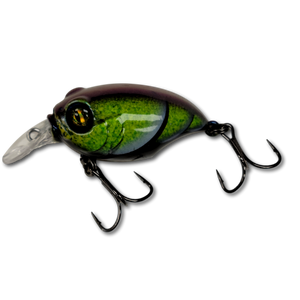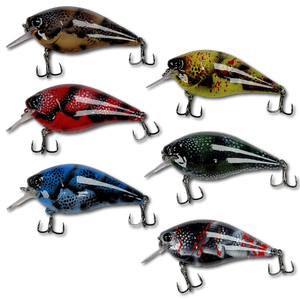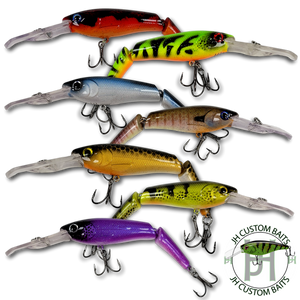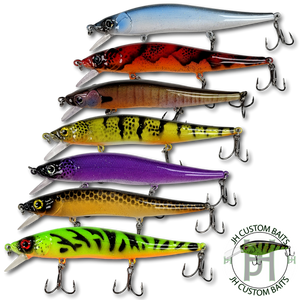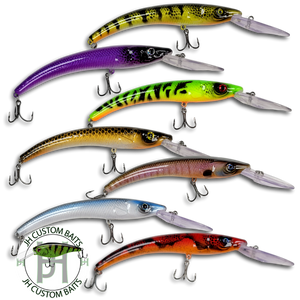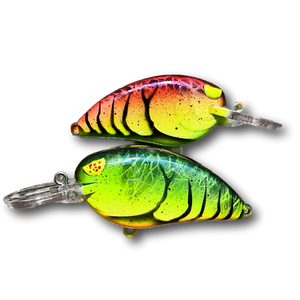Lipped crankbaits are hard plastic lures equipped with a diving lip that determines their depth and action. The size and angle of the lip dictate how deep the bait dives and how aggressively it wobbles through the water. These baits are highly effective at mimicking natural forage, such as baitfish, crawfish, or other prey, making them a go-to option for covering water quickly and targeting predatory fish.
Lipped crankbaits are available in a range of styles, from shallow-diving to deep-diving models, allowing anglers to target fish at virtually any depth. Their ability to draw reaction strikes makes them especially useful in challenging conditions or when fish are holding tight to cover.
Lipped crankbaits come in several styles, each designed for specific depths and fishing scenarios:
Shallow-Diving Crankbaits:
- Dive to depths of 1–5 feet.
- Perfect for fishing shallow flats, around vegetation, or near submerged timber.
Medium-Diving Crankbaits:
- Dive to depths of 5–12 feet.
- Ideal for targeting fish holding on mid-range structures, such as points, humps, or drop-offs.
Deep-Diving Crankbaits:
- Dive to depths of 12 feet or more.
- Excellent for fishing ledges, deep brush piles, or channels where fish are suspended or holding close to the bottom.
Lipped crankbaits are versatile and effective in a variety of conditions. Here are some popular techniques:
Steady Retrieve: The simplest and most effective method, a steady retrieve allows the bait to dive to its target depth and maintain a consistent wobble.
Stop-and-Go: Add pauses to your retrieve to let the bait float up slightly, mimicking an injured baitfish. This technique triggers reaction strikes as the bait restarts its movement.
Deflecting Off Cover: Cast crankbaits near rocks, stumps, or submerged timber and let the diving lip deflect off the structure. This erratic movement mimics fleeing prey and often provokes aggressive strikes.
Bottom Bouncing: Allow deep-diving crankbaits to make contact with the bottom, stirring up sediment to imitate crawfish or bottom-dwelling forage.
Burning: Retrieve the crankbait quickly to mimic a fleeing baitfish, an effective technique for targeting active fish in warm water or low-light conditions.
Lipped crankbaits are effective year-round and can be used in a variety of environments:
- Spring: Shallow-diving crankbaits excel during the pre-spawn, targeting fish near shallow cover or transition zones. Crawfish-colored crankbaits are particularly effective during this time.
- Summer: Medium- and deep-diving crankbaits shine as fish move to deeper water. Target ledges, humps, or submerged brush piles with steady retrieves or bottom-bouncing techniques.
- Fall: Shad-patterned crankbaits mimic baitfish during the fall feed. Fish shallow-diving crankbaits near riprap, shallow flats, or transition zones.
- Winter: Deep-diving crankbaits with a subtle wobble can be effective for targeting lethargic fish holding near deep structure. Slow down your retrieve to match the fish’s activity level.
Lipped crankbaits are highly effective in lakes, reservoirs, rivers, and ponds with a mix of cover and structure.
Best Colors and Sizes for Lipped Crankbaits
Selecting the right color and size is essential to matching local forage and conditions:
- Clear Water: Use natural colors like shad, silver, or translucent patterns to mimic baitfish.
- Stained or Murky Water: Bright or high-contrast colors like chartreuse, fire tiger, or red help fish locate the bait.
- Low-Light Conditions: Darker colors like black or purple create a strong silhouette.
Crankbait sizes typically range from 1.5 to 3 inches. Smaller baits are effective for finesse presentations or targeting smaller fish, while larger baits are better for aggressive or larger fish.
Why Lipped Crankbaits Are So Effective
Lipped crankbaits excel because of their ability to cover water quickly and target fish at specific depths. The wobbling action and lifelike appearance mimic natural forage, while the diving lip allows anglers to control the bait’s movement and deflection off cover.
The combination of vibration, flash, and versatility makes lipped crankbaits a reliable choice for both novice and experienced anglers. Whether you’re fishing shallow flats, mid-range structures, or deep ledges, these baits consistently deliver results.
Tips for Fishing Lipped Crankbaits
- Use the Right Gear: Pair lipped crankbaits with a medium-action rod and fluorocarbon line (10–17 lb test) to maximize casting distance and maintain sensitivity.
- Match the Hatch: Choose colors and patterns that closely resemble the forage in your area for the best results.
- Vary Your Retrieve: Experiment with speeds and pauses to find the most effective presentation for the fish’s behavior.
- Focus on Key Areas: Target structure, cover, and transition zones where fish are likely to be holding.
Lipped crankbaits are a must-have for any angler looking to cover water efficiently and effectively. Their diving action, lifelike wobble, and versatility make them one of the most reliable tools for targeting predatory fish in various conditions. Whether you’re fishing shallow cover, mid-range drop-offs, or deep ledges, lipped crankbaits are built to deliver. Stock up on your favorite styles, colors, and sizes, and let these dynamic baits take your fishing success to the next level.
Qwik Catches!








